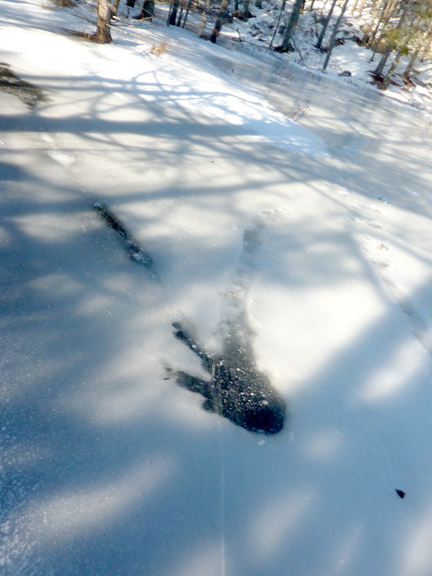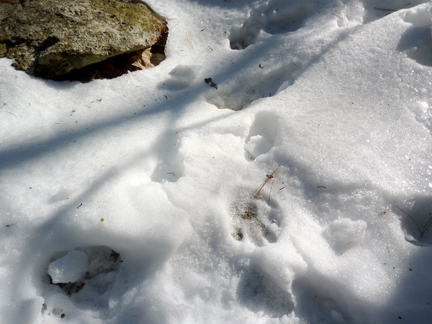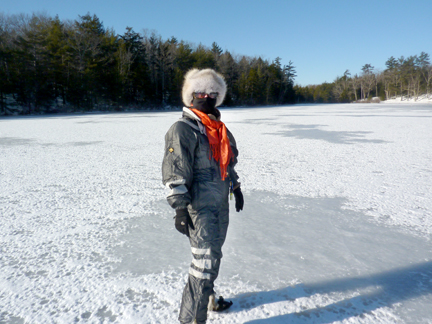It is a clear January morning, and the temperature outside is three degrees. The ground is white with snow that has crusted over and looks as hard and cold as ice. I feel chill off the windowpane when my hand is still inches from touching it, and the lack of wind and motion makes the world seem frozen into stillness. It is a Sunday, and the winter world beckons me outside to play. It is a day for Mrs. Peel.
Fans of the 1960s television series The Avengers will remember Mrs. Peel, played by Diana Rigg, who was fit and formidable, quick-witted, and always stylish. She was a role model, and a few years ago when I acquired a one-piece Descente snowsuit to take me comfortably into subzero weather I named the suit Mrs. Peel. Metallic gray with silver slashes on the sleeves and back, a red satin lining and space age padded shoulders, it, too, is very sixties. Add a fur hat and fur boots, sure-footed ice creepers, silk underclothing and I become invincible, as ready-for-anything and gutsy as Mrs. Peel herself.
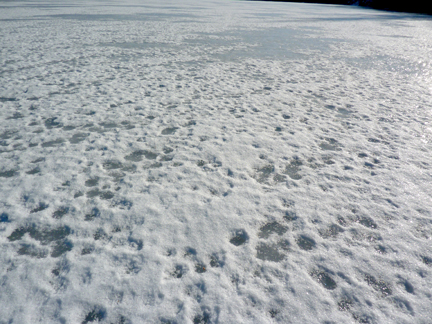
This was to be just a short adventure, as there were tasks and chores to do before the day was done. A small, sheltered lake a few miles from home has frequently offered tracks and animal sign and I felt like tracking, so I headed to Lakewood, easily reached down an unplowed stretch of road.
Mrs. Peel and I headed out onto the ice. It groaned and snapped, booming as it expanded, making ice as some call it. Most liquids contract as they freeze, but water, forming intricate crystals with space between the branches and spikes of each exquisite structure, expands. When it has nowhere to go it cracks and booms. There is one loud explosive bellow, then, a gentle reply. The sound bounces off the surrounding hills repeating itself more and more softly until silence returns. Lakewood is a small lake, and the booms were modest, not heart-stopping as they can be on bigger waters.
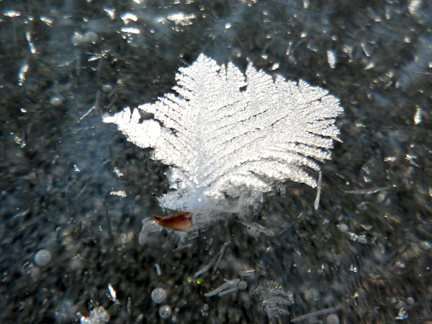
The surface of the lake, so perfectly flat and level, was puckered with the imprints of what seemed to be a thousand small cat paws. Kneeling and tracing the outline of one imprint, I could imagine the party of prancing, leaping cats that might have left such patterns in the ice. Standing and looking across the lake I saw the focused unwavering trail of a coyote. I had passed human and dog track on the road in, and the erratic roam and sniff and run back to master trail of the domestic dog is strikingly different from an animal in the wild, for whom conserving energy is a matter of survival.
A frozen tadpole lay on the surface of the ice, apparently tossed out of a bait trap and left as an offering for some fortunate diner. Over an inch wide, the snakelike head would have become a bullfrog’s head in the spring. Life is full of hazards out on the ice.
An even smaller pond is connected to Lakewood, called Fawn Pond. Here a skim of black ice lay over a stream feeding the larger pond below. Black ice. The name is fearsome, implacable, but the underwater scene it reveals is beautiful in its otherworldliness. I lie on my belly and peer through the ice. I can see thin grasses waft slowly in the current. The sunlight pierces through to the bottom, illuminating a few gray and gold speckled rocks, but they are as far away as the moon. I cannot touch them; they are on the other side of that invisible ice wall. The untouchableness makes this world even more compelling. I am on the outside, looking in, and I want to dive down and explore. I run my gloved hand over the ice and it feels astonishing that it has no effect, that a barrier prevents my hand from simply sliding below the surface. Ice crystals form intricate leaf-like shapes and lie on the surface of the ice. A large twig shifts and dips. A caddisfly larva had changed its center of balance and clung, bouncing gently, to the branch. It wore a case it had made of bits of rock and twig and weed, and until it moved seemed part of debris on the stream’s bottom. Confined behind a wall of glass this larva, creeping, barely moving as it goes about its business, seems to have no relation to the swarms of long-antennaed shadflies, or caddisflies, that will be in my face and hair a few months from now.
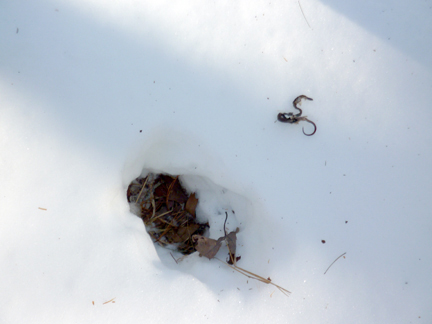
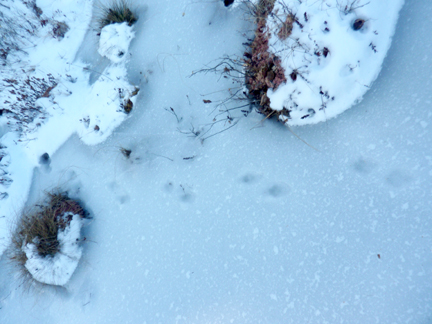
At the edge of the stream something had dug a hole through the snow to the leaves and earth below. Whatever hunter this was found the prey it had sensed, and the curled remains of the slim milk snake rudely pulled from his winter’s sleep lay discarded nearby. There is no safety even buried in the dirt, below several inches of snow, and a crust of ice.
Fawn Pond was larger than last time I was here. The beavers had been busy, and a long dam kept the water from flowing to the lake. A mound of branches and tree limbs with the tiny teeth marks of the beavers was piled over their underwater retreat. Crystals, formed when the warmth from beavers’ exhalations mingled with the colder air outside, rimmed a few twigs at the top, sure sign there were beaver below. Skirting the edge of the beaver lodge were pairs of small dimpled prints, the bounding gait of either a mink or a weasel. I followed these along the edge of the pond, as they led to Lakewood and the woods road to my car. At the stream where the two ponds joined an otter had left sliding marks on the ice, and a hole where he went below the surface. Clear otter prints and chutes went over the dam, along the stream, and down the ledges back towards Lakewood. It was a steep descent, and the water fell in a series of short falls, framed by long clear cliffs of ice. The otter had cruised around saplings, bounded over small rills, and shot down steep slopes, seemingly having fun, and heading towards home. Mrs. Peel slid and wriggled right behind, leaving larger slide marks and prints for the next tracker to examine.
It was a short adventure, perhaps only two and a half miles, but there was life, and there was death. There were remote worlds and minute details. There were deer, dogs, humans, coyotes, chickadees, a tadpole, snake, caddisfly larva, otter, weasel or mink, mouse, and beaver.
Let me know what tracks you may have seen!
